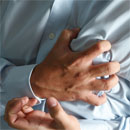 Heart attacks are generally described as severe cardiovascular events that are characterized by chest pain, shortness of breath, and intense sweating. The appearance of these symptoms often prompts medical attention in order to provide proper treatment to the patient. The immediate medical treatment will also ensure that the individual will live longer. Various health groups have been aggressively campaigning that people follow healthy lifestyles for heart attack prevention and in order to live longer.
Heart attacks are generally described as severe cardiovascular events that are characterized by chest pain, shortness of breath, and intense sweating. The appearance of these symptoms often prompts medical attention in order to provide proper treatment to the patient. The immediate medical treatment will also ensure that the individual will live longer. Various health groups have been aggressively campaigning that people follow healthy lifestyles for heart attack prevention and in order to live longer.
There are also heart attack prevention and educational programs that provide information of how to detect heart attacks, including the signs and symptoms of its onset. Heart attack prevention schemes in order to live longer also describe healthy meals that are rich in fiber and protein, thus decreasing the accumulation of fatty acids and sugars in the body, factors that increase the likelihood of suffering from heart attacks.
Related Article: 5 Signs You Are Having a Heart Attack
Advertisement
The Center for Disease Control and Prevention (CDC) has recently released a report that current studies now show that the most common signs and symptoms associated with heart attacks are changing. The CDC cited the latest article published in the Journal of the American Medical Association (JAMA) that there are gender-specific differences in the presentation of heart attacks. The JAMA report authored by Dr. Canto and colleagues described that women often do not experience any chest pain during heart attacks, unlike what is commonly observed among men. In addition, any other signs of discomfort during heart attacks, such as difficulty breathing and profuse sweating, also do not appear in female patients and thus heart attack prevention to live longer might not be performed when the obvious signs are absent. Although there are also some male patients who do not experience chest pain during heart attacks, its incidence among women far surpasses the number of cases occurring among men and thus changes their chances for proper treatment to live longer.
This gender-specific discovery relating to heart attacks may thus influence schemes on heart attack prevention and detection, as well as health programs to live longer. For years, heart attack prevention programs teach the public that chest pain and discomfort are the major signs of heart attacks and health programs on how to live longer have also focused on being vigilant of these signs. The JAMA report will possibly change our current understanding of heart attacks and will definitely require modifications in schemes on heart attack prevention.
Another alarming information presented in the recent JAMA report involves the absence of chest pain among younger women suffering from this cardiovascular event and its association with a higher mortality rate and a lower chance to live longer. This is mainly due to the delay or absence of appropriate diagnosis and medical treatment, which play a critical role to live longer. An even greater difference in the number of elderly women without chest pain as compared to elderly men was observed. Heart attack prevention schemes should therefore include other biomarkers for detecting this event, including blood work and other cardiovascular tests.
The JAMA medical report was based on reviewing symptoms developed by over 600,000 male and 400,000 female patients enrolled in the National Registry of Myocardial Infarction from 1994 to 2006. This comprehensive study was conducted in order to determine the association between gender and heart attack symptoms. The results of the study may also play an instrumental role in reviewing heart attack prevention programs that are nationally recognized. This novel finding also highlights the importance of identifying rare symptoms of heart attacks, in order to inform the public that chest pain and shortness of breath are not the only major symptoms of this cardiovascular event. In addition, heart attack prevention programs can also include this new information in their brochures, helping the readers to understand additional methods on how to live longer.
